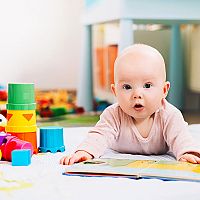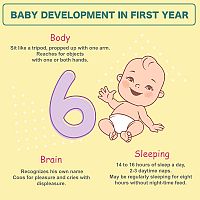
6-month-old baby (child) - development, diet, sleep, exercises, toys. See what it can do
Although each month in the baby's development is often referred to as a "turning point", in the case of the 24th week, or This is definitely true on the 6th of the month. Many moms realize at this milestone that the 6-month-old "little" baby is already becoming a child. Although he still has the status of an infant, a 6-month-old child is already a receptive and understanding member of the family. Many parents will confirm that a six-month-old baby becomes more proactive, playful and shows interest in everything around him. He doesn't like being in one place anymore, he starts to act independently and discovers his movement skills. The grip has strengthened and emotional manifestations are associated with specific phenomena. Games for a 6-month-old baby are more diverse, and speech is also developing.
The child's activity increases significantly in the 6th month. The reason is that his perception is much more sensitive. If until now it has been lying on its stomach and occasionally reaching for a toy, it is now starting to discover its movement possibilities and some children may make their first attempts at crawling. The baby bends the arms in a controlled manner and leans on the open palms. It doesn't just wait for you to place it, it starts to initiate movement on its own and the curiosity is truly endless. He is going through a growth spurt. Again, sleeping habits may also change slightly. Speech is developing and it is the right time to start feeding the child - his diet will also consist of more solid and especially non-dairy food.
What can a 6-month-old baby do?
At this age, most children can already roll over from their back to their side and stomach and back again. Rolling over from stomach to back may not always be successful, but it is just an exercise in the given movement. In the course of the movement, attraction appears more prominently. If the child can lean on something or grab onto something, he can push himself away or pull himself up. For example, if you give the baby your fingers, he will pull himself into a sitting position. However, it is still true that the baby should not remain in the sitting position for a long time. If the child is not yet able to sit up on his own with his feet forward, limit the sitting position. The position of sitting on the "flip-flop" appears more often, in which the child sits on his bottom and supports himself in front of him with his hands. However, also limit this position due to the development of the back muscles. The smarter children with a faster pace will also pull themselves up to a standing position, directly from lying down.
It is not surprising if signs of crawling appear at the end of the 6th month. Most often with the help of hands. If you hold the child under the armpits, he tends to push his feet against the mat, but these are just reflexes and we cannot talk about walking yet. The child's grip also strengthened. Therefore, he can attract or push away with his hands. Motor skills in the hands improve and it is possible that the child can pass an object from hand to hand. The coordination of movements improves significantly. The child has no problem grasping objects made of different materials. Begins to use the thumb for grasping and often grabs an object in a groping manner. Do not compare your baby's progress with others. Each child develops at a different pace. Do not neglect regular visits to the pediatrician, so that possible deficiencies or deviations in development can be detected in time.

Baby vision, perception and speech at 6 months
Sight is already developed to about 60 to 80 percent. Color vision is more developed and also sharper. During this period, the eye color should definitively change to the final color that the child will have for the rest of his life. The child already perceives dynamic objects and peripheral objects well. He is interested in picture books or moving objects outside. Pointing is slowly becoming a communication tool. Squinting or uncontrolled eye movements should no longer be present in the 6th month and the child can actively maintain eye contact. If the movement of the eyes is asymmetrical, it is necessary to find an ophthalmologist and carry out a diagnosis - an ophthalmological examination.
Many parents agree that, compared to the first months, crying is on the decline in this period. While awake, the baby appears to be still preoccupied, babbling, purring, cooing and laughing loudly. The child begins to respond to his name. He gradually understands gestures, sounds and even a change in the intonation of the voice, for example in prohibitions. He may already have his favorite toys or pictures. A strong maternal instinct is also beginning to manifest itself in him. He often prefers his mother when feeding, playing, bathing or putting him to sleep. He expresses his discomfort from the presence of another person with a frightened look and crying. Such a phenomenon is also called separation anxiety, which appears in children between 6 and 12 months. The child does not need to be deliberately denied closeness to the mother. It is about the natural creation of emotional bonds.
Speech is also developing. New voices appear, although very often it is just a mix of them. Maybe you hear the first syllables like ma-ma, ba-ba, ta-ta and the like. He imitates your words, talks to toys or reacts to himself in the mirror. He develops a passive vocabulary and begins to understand many words in context. It is an ideal time to show objects and associate them with the child. He begins to associate objects, for example, a car - "brm-brm" or a clock - "tick-tock". He regularly smiles, grimaces and is definitely not the silent companion he was weeks ago. It is advisable to start practicing movement games with the child, e.g. movement poems such as "Tap-tap tapušky" or "Wheel-wheel mill". Include gestures, facial expressions, clapping or shelling.

6-month-old child - food and snacks
For 6-month-old children, it is advisable to start feeding complementary foods, i.e. the first non-dairy food. For children fed with artificial milk, complementary foods are started earlier, around 4-5 months. This step is also very important from the point of view of the immunological window, which "opens" between the 4th and 7th months of the baby's life. This is a suitable period during which the child's organism and digestive system comes into contact with other food components and also potential allergens. Tolerance to previously unknown food components occurs here. Get a plastic spoon, bowl or plate and also a dining chair.
Does a 6-month-old child not want to eat snacks ? Food does not always have to suit the child. If he refuses, try the food in a week or two. Start gradually with cooked mixed vegetables, later with fruit puree and only later with combinations of fruits and vegetables. Before each new food, it is advisable to leave the child a distance from the previous one. So, if you give your child mixed carrots for the first 3 days, add broccoli only on the 4th day, another food on the 7th day, and so on. You can monitor possible reactions in the baby's digestion. You can find dozens of recipes for preparing snacks for a 6-month-old baby on the Internet.
The main ingredients should be vegetables, fruit, fiber or meat (chicken, rabbit, turkey). Gradually try non-dairy rice or corn porridge, barley groats, oatmeal for soup, and later also boiled yolk and egg white. It is important to understand that this is a milestone for your baby as well, and these changes in eating habits should be applied gradually. In some cases, pediatricians and immunologists disagree that children under 12 months should not eat strawberries, cottage cheese, mushrooms, poppy seeds, nuts, eggs, honey or chocolate. Primarily due to strong allergens or immaturity of the kidneys and digestive system. You should also not salt food for a child under the age of 1. Even the introduction of complementary foods does not mean that the mother should stop breastfeeding the baby with breast milk. Side dishes become only a part of the child's diet, not a full replacement.

Sleeping habits and games for a 6-month-old baby
During the day, the baby sleeps less and less. It is often 2 or 3 periods of sleep for 1 to 2 hours. The rest of the day the baby is awake and interested in the world around him. He sleeps approximately 10 hours during the night. However, the sleep of a 6-month-old baby can have its own specifics in any case. The first milk teeth may appear, which may be associated with impaired sleep, increased temperature, swelling of the gums, tearfulness or irritability. The so-called sleep regression. Thus, a 6-month-old child can be nervous and dissatisfied even though his needs are met. The child is going through a growth spurt, turns over more significantly during sleep and can easily wake up when changing position. The subsequent crying is often a mystery to parents. The central nervous system also matures. After waking up, separation anxiety and the need to have a parent with you are often manifested. Regression manifests itself in worsening falling asleep and, consequently, more frequent awakenings during nighttime sleep. This state sometimes lasts a week, sometimes even a month or longer.
You can playfully stimulate a 6-month-old child with various games and thus encourage his psychomotor development. Use different toys, wooden blocks, play poetry and movement games, clap your hands, play with a rattle or point your finger at specific objects and pictures, while associating them with sound. Be careful with smaller toys, as the phase when the child is tasting everything is still going on. Speak to the child, address him by name.

The most frequent questions - FAQ
Perhaps you too are wondering what a 6-month-old baby should know or you would like to find out how a 6-month-old baby should develop. You can read basic information in our article. It is important for mothers to remember that every child is different and the pace of development can be different. What a 6-month-old can do depends on many factors. The real experiences of parents are very helpful. If you have your own knowledge of parenting, we will be happy if you share your practical advice with us. Join the discussion under the article.
How much solid food should a 6-month-old baby eat?
How much water should a 6-month-old baby drink?
Is soup suitable for a 6-month-old baby?
Gallery
Pridať komentár













